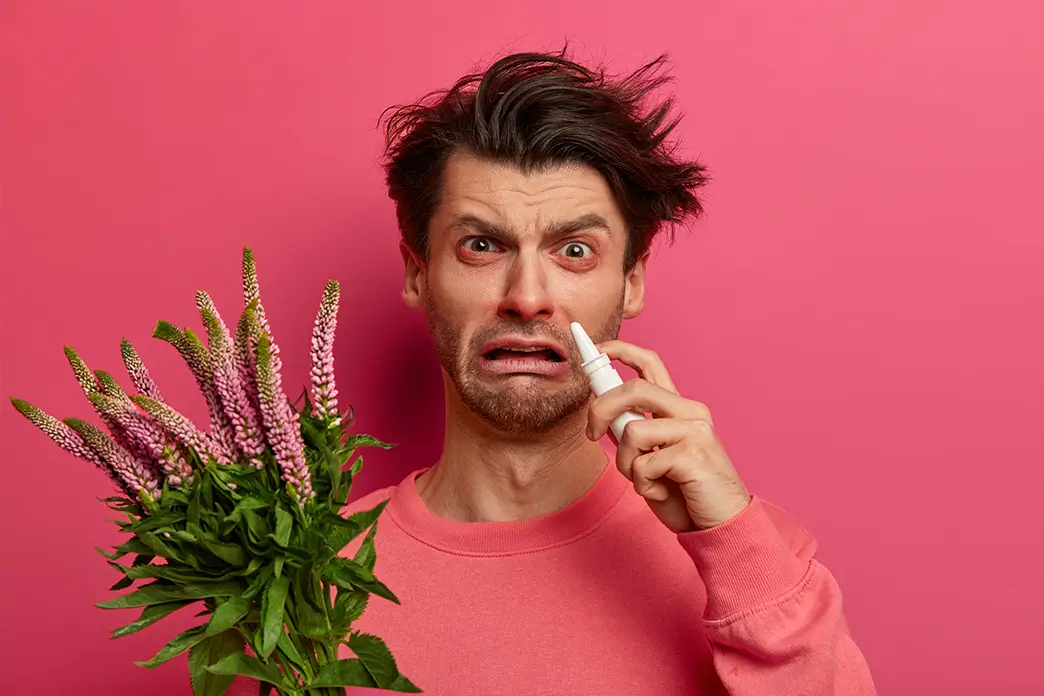
Allergies – From Hay Fever to Hyposensitization
An allergy causes the immune system to react to essentially harmless substances we come into contact with by triggering a defensive reaction. Who hasn't experienced typical hay fever, which manifests through symptoms like sneezing, coughing, or swelling of the airways when inhaling flower pollen? Various substances—known as allergens—such as pollen, animal hair, house dust, certain foods, or medications can trigger allergic reactions. Most allergies result in rather bothersome symptoms, but occasionally, severe immediate reactions can occur, leading to a life-threatening anaphylactic shock.
Contents
Contents
The likelihood of suffering from at least one allergy is high. A survey by Statista Research in 2022 showed that in Germany, about a third of all women (34 percent) and more than a quarter of men (27 percent) complained of allergic reactions. Across Europe, about 30 percent of the population is considered "allergic," with the number, type, and severity of allergies varying greatly from person to person. While seasonal allergies such as pollen and grass allergies cause problems for only a few months each year, year-round variants like house dust allergies can be triggered at any time.
An allergy test can easily detect most allergies. However, research is only slowly uncovering the causes of allergies. Fortunately, medications for allergic reactions are already available. And with hyposensitization, some allergies can be weakened or made manageable. This article provides current knowledge about allergies, offering information about different allergies, possible causes, consequences, and treatment options.

What causes allergies?
Allergies can have various causes. First, it seems that the number of allergy sufferers is steadily increasing, especially in the Western world. Medical data from the early years after German reunification show that hay fever affected only half as many people in the new federal states compared to the old ones. Just ten years later, the number of cases in East and West had almost balanced out. In recent decades, the frequency of allergies has increased in all Western industrialized nations, while it has practically stagnated in countries like India, China, or the Balkans. One of the main hypotheses about potential triggers of allergies focuses on individual living conditions.
The so-called hygiene hypothesis suggests that an under-challenged immune system—especially in young years—can lead to the development of allergies. Simply put, children in Western nations don't play enough "in the dirt." They lack sufficient contact with various bacteria, which "train" the T-helper cells of the immune system. As a result, the T-helper cells may mistake harmless substances for threatening ones later in life and trigger corresponding immune responses. Growing up close to nature with much contact with animals and plants and overcoming various childhood illnesses should, according to this hypothesis, reduce the likelihood of developing allergies.

Environmental pollution is considered another factor in the development of allergies. This does not only potentially affect the human immune system – trees and shrubs could also change under the influence of exhaust gases and toxins, causing stronger allergies. Furthermore, the spread of allergens can be facilitated by attaching themselves to fine dust particles from soot and car exhaust. Many pollen particles are small enough for this and are inhaled along with the pollutants.
The influence of genetics on allergies is not yet fully understood, but it is already known that children of allergy sufferers have an increased risk of developing allergies themselves.
What types of allergies are there?
The list of different allergy triggers is long. The main differences lie in how we absorb the allergens and what symptoms they cause. Many allergens, from pollen to animal hair to house dust, float in the air as fine particles and are inhaled. Allergens in peanuts, fruits, or other foods enter the body through ingestion. Allergies that are triggered by simply touching the allergen—such as nickel allergies or latex allergies—are less common. Some people are even sensitive to UV light and develop a so-called sun allergy.

A distinction is made between seasonal and year-round allergies. Flower pollen and grasses enrich the air mainly from spring to autumn. Some pollen types even fly well into November. However, the most challenging time for seasonal hay fever sufferers is in spring and summer. Year-round allergies are those that are "always there," as allergens like house dust, nickel, latex, or peanuts can trigger an allergy at any time of year. Sun allergies are often weaker in winter as less skin is exposed to the sun and the UV index is lower during winter months.
A cross allergy is when the symptoms of an existing pollen allergy occur when consuming certain foods. Almost two-thirds of pollen allergy sufferers are more or less affected by a cross allergy. The most well-known example is the combination of apple and birch. The birch pollen allergen is so similar to the allergen in apples that the immune system treats the substances the same way. If a cross allergy is severe, sufferers may need to adjust their eating habits under medical supervision.
Autoimmune diseases
Autoimmune diseases are particularly tricky because they cause the immune system to attack the body's own cells and tissues. A well-known example is "Lupus," which manifests through chronic inflammation of the connective tissue, joints, and various organs. Diagnosing and treating autoimmune diseases poses significant challenges for physicians. Possible triggers include viral infections, the aftermath of bacterial infections, or the overproduction of white blood cells. Some sufferers need to take medication for life to suppress the immune system. In other cases, autoimmune diseases seem to heal on their own and disappear again.

The different types of allergies
The mechanism by which allergies are triggered in the body does not always work the same way. Additionally, there are differences in how allergens enter the body and how long it takes for the first symptoms to appear. In medicine, allergies are therefore classified into four different "allergy types."
- Type 1 allergy: Type 1 is also called "immediate type" because allergic reactions occur immediately or within a few minutes—at most within half an hour. Typical symptoms of a type 1 allergy are skin rash, itching, swelling, sneezing, or coughing. In severe cases, shortness of breath or anaphylaxis can occur—immediate emergency care can then be crucial. In addition to pollen, dust, and animal hair, insect stings are also triggers of the immediate type.
- Type 2 allergy: Six to twelve hours after contact with the allergen, the immune system becomes active in type 2 allergy. It is also known as the "cytotoxic type" because specific antibodies are formed to destroy foreign structures but attack the body's own tissue. This allergy type often occurs in connection with blood transfusions.
- Type 3 allergy: The so-called "immune complex type" also manifests six to twelve hours later. Allergens combine with antibodies to form the eponymous immune complexes. As soon as these are absorbed by phagocytes, enzymes are released that irritate and damage the surrounding tissue. Type 3 allergies often result in inflammatory vascular diseases.
- Type 4 allergy: If allergy symptoms do not appear until at least twelve hours later, it is likely type 4, the "delayed type." This delayed triggering type sometimes only occurs days later and can remain active even when no allergen is present. Nickel allergy, for example, usually occurs as a delayed type.
What are the most common allergies?
The most common allergies are often triggered by substances that we can hardly avoid in everyday life. Mild manifestations are often not immediately recognized as allergies, because when enough dust or flower pollen gets into the nose, everyone will sneeze. It is only when the allergic reactions go beyond the normal irritation response that most sufferers realize they are allergic. Other allergies can be quickly recognized by their symptoms. As many people today are already aware of the existence of allergies, initial allergy tests are often conducted in childhood.

Here is an overview of some of the most common allergies:
- Hay fever: Behind the widespread hay fever are pollen allergies. Various plants spread their pollen to fertilize each other. As tiny particles, pollen drifts through the air—when inhaled, the proteins they contain can trigger allergic reactions. Typical symptoms of a pollen allergy are sneezing, an itchy and runny nose, or watery eyes. In more severe cases, headaches or even shortness of breath and the development of allergic asthma can occur. It is suspected that factors such as smoking, passive smoking, or air pollution promote the development of pollen allergies. In Central Europe, hay fever is mainly caused by the following pollen: alder and hazel from January to March, ash and birch from April to summer, mugwort from August to autumn, and grass pollen from late spring to autumn. Learn more in our blog post about hay fever.
- House dust allergy: Dust accumulates in every house and is almost unavoidable. However, the dust itself causes at most mild respiratory irritation—the house dust allergy is a reaction to substances in the feces of mites. These partly microscopic arachnids are practically everywhere—they live in carpets, curtains, bedcovers, etc. The allergy manifests through cold-like symptoms, less frequently through eye irritation. House dust allergies are rarely severe and are more annoying than dangerous. However, in some cases, asthma can develop. In rare cases, cross allergies with the consumption of shellfish are known. Regular household hygiene is usually sufficient to keep the amount of dust and allergens at a tolerable level. It is recommended to do a lot of damp cleaning to avoid stirring up dust unnecessarily while cleaning. Learn more in our blog post about house dust allergies.
- Animal hair allergy: Again, the name of the allergy is somewhat misleading because it is not the hair of popular pets like dogs or cats that causes problems. The allergies actually arise from specific proteins in the animals' saliva. During grooming, the proteins get into the animal's hair and spread throughout the household with shed hair. There, the allergens can float in the air for a long time as tiny particles. Cat allergies are most commonly triggered, closely followed by dogs. Cat allergy sufferers are usually allergic to all cat breeds, although some breeds produce less allergenic saliva. Dog allergy sufferers are sometimes only allergic to certain breeds. The symptoms often resemble a cold, with swollen and watery eyes also typical. Frequent cleaning of areas frequented by animals and installing air purifiers can help reduce allergen exposure. Learn more in our blog post about animal hair allergies.
- Sun allergy: If welts, blisters, or itchy rash develop one to two days after sun exposure, there is likely a hypersensitivity to UV radiation. Technically speaking, "polymorphic light eruption" is not an allergy. The exact reasons are still unknown, but this overreaction often occurs when the skin comes into contact with sunlight more intensely after the winter months and then subsides again. Those prone to severe manifestations should seek medical advice—sometimes the skin can gradually get used to UV light through light therapy. Learn more in our blog post about sun allergy.
- Contact allergies: These allergies can be very tricky as their symptoms often do not appear until twelve hours, sometimes even days after contact with the triggering substance. By far the most common trigger of a contact allergy is the metal nickel. Those affected may be unable to wear nickel-containing jewelry or need to ensure their skin does not come into contact with metal buttons. The contact site shows redness, swelling, or welts when the allergy occurs. In severe cases, oozing blisters or, in the worst case, chronic contact eczema with keratinization and scarring may develop. Since the reaction occurs so late, severe symptoms can already occur the first time it appears. If the trigger is identified, it can be avoided, and sufferers remain symptom-free. Desensitization, as with other allergies, is not yet possible. Learn more in our blog post about contact allergies.
- Food allergies: They are very common and exist in various forms and varieties. A food allergy can cause symptoms such as swollen or tingling oral mucosa, bloating, abdominal pain, or hives. In rare cases, however, a life-threatening anaphylactic shock can occur—the peanut allergy is a typical trigger here. While some food allergies manifest immediately, others belong to the delayed types, making their diagnosis extremely difficult. Fortunately, severe food allergies are rare. Learn more in our blog post about food allergies.
- Gluten allergy: Another colloquial term often used broadly for intolerances to wheat or the gluten found in various grains. The symptoms, ranging from bloating to severe diarrhea, may indicate wheat intolerance or celiac disease. Severe diarrhea symptoms suggest celiac disease—an autoimmune disease of the small intestine lining. Corresponding symptoms after consuming foods containing wheat or other grains should be clarified by a doctor.
- Insect sting allergy: An allergy to insect venom can cause severe, sometimes even life-threatening immediate reactions to wasp or bee stings. Stings in the throat and mouth area, or even in the mouth or throat, are particularly dangerous. The resulting swelling is already dangerous for non-allergic people—with an insect venom allergy, the swelling is so severe that there is an acute life threat. Cramps, diarrhea, vomiting, and rapid heartbeat can be further symptoms of an insect sting allergy. Learn more in our blog post about insect sting allergies.
- Drug allergies: Medications often contain a variety of active ingredients and other substances. Some of these can trigger allergies. Allergic reactions often occur immediately after taking the medication but can also be delayed by hours or days. The variety of possible triggers can make it difficult to identify a medication allergy. Relatively common and well-known allergies exist against ingredients in some antibiotics or the acetylsalicylic acid (ASA) contained in aspirin. If a drug allergy is present, the substance must always be avoided. Hyposensitization is not possible. Learn more in our blog post about drug allergies.
- Lactose intolerance: A true allergy to lactose is extremely rare. Those who cannot tolerate cow's milk usually suffer from lactose intolerance. Lactose is a sugar also found in human breast milk. Healthy digestion splits lactose in the small intestine into glucose and galactose—in an intolerance, lactose is not properly digested and is only broken down in the large intestine. This produces typical symptoms such as bloating, a feeling of fullness, cramps, or diarrhea. Severe lactose intolerance requires a dietary adjustment under medical supervision. However, it is not life-threatening.

How can I recognize an allergy?
If you frequently experience symptoms such as watery eyes, itching, sneezing, skin rash, or welts, an allergy might be the cause. The reason is not always immediately apparent—the finest pollen or dust particles are invisible to the human eye. Other allergies only manifest hours later, making it harder to find the cause. Try to remember if the symptoms occurred in connection with a food, taking medication, or an insect sting and how long it took for the symptoms to appear. When you seek medical advice, you will be asked about these things among others.
Reliable information about allergies can only be obtained through an allergy test. Consult your trusted doctor—many general practitioners or dermatologists are also allergists. In most cases, a skin test is conducted for this purpose. The standard method is the so-called prick test. Allergens contained in a neutral liquid are dripped onto the skin. A fine needle is then used to pierce through the drops into the upper layer of the skin, allowing a small amount of the allergen to seep into the skin. If the affected area swells in the following minutes, an allergy is present. This method can test numerous allergies and their severity at the same time—usually on the skin of the back.
A similar method is the epicutaneous test, where aluminum discs coated with a mixture of allergens and petroleum jelly are placed on the skin. This method is used to identify contact allergies. Since these allergies are delayed types, the aluminum patches often need to be worn for several days. Occasionally, blood tests or provocation tests, where the allergen is inhaled, are used for allergy diagnosis.

Can allergies be cured?
According to current scientific knowledge, allergies are not curable. However, they can usually be treated and in some cases suppressed to the point where they cause little or no discomfort. In severe, life-threatening cases, the body's immune response can be suppressed with special medications. Of course, such treatments can have other side effects. If possible, it is preferable to avoid the allergy trigger completely. If this is not possible or desired—for example, because you do not want to give up your pet—the method of hyposensitization offers the best chances of success.
During hyposensitization, patients are deliberately given small amounts of the allergen. The treatment begins with an extremely low dose, which is gradually increased over weeks and months. By continuously coming into contact with small amounts of the allergen, the immune system can slowly get used to it. This is known as immunological tolerance. This treatment method has already achieved very good results. Allergic symptoms can be reliably reduced, and not infrequently, the symptoms disappear completely after the therapy. Hyposensitization can be used for immediate-type allergies, such as pollen, dust, or animal hair allergies.
Can an allergy disappear on its own?
There are reports of cases where allergies have supposedly disappeared without any apparent reason. However, these cases are rare, and the reasons for the alleged healing are unclear. However, it is known that allergies often weaken over the course of a lifetime. This is likely because the immune system reacts faster and more intensely in younger years. Since it is not possible to avoid many allergens completely in everyday life, a form of "passive desensitization" probably plays a role in the weakening of allergies. This is especially true for common allergies like pollen, dust, or animal hair allergies.

Conclusion
Allergies are part of our lives, and in most cases, we can live with them. Hyposensitization, in particular, has already helped many sufferers. If you suffer from a severe allergy, you should not rely on it weakening or spontaneously healing. Seek medical advice, as help is often available. Since some allergies can also worsen, at least an allergy test is recommended to assess the severity of any existing allergies.
Research indicates that a healthy, active lifestyle is best suited to counteract the development of allergies or at least severe manifestations. You often hear the famous saying, "let children play in the dirt," because to build a healthy immune system, it must encounter possible pathogens. However, whether and how exactly an allergy develops varies from person to person. If in doubt, visit an allergy clinic to have your individual situation clarified by medical professionals.
We wish you a pleasant summer – even with allergies!



